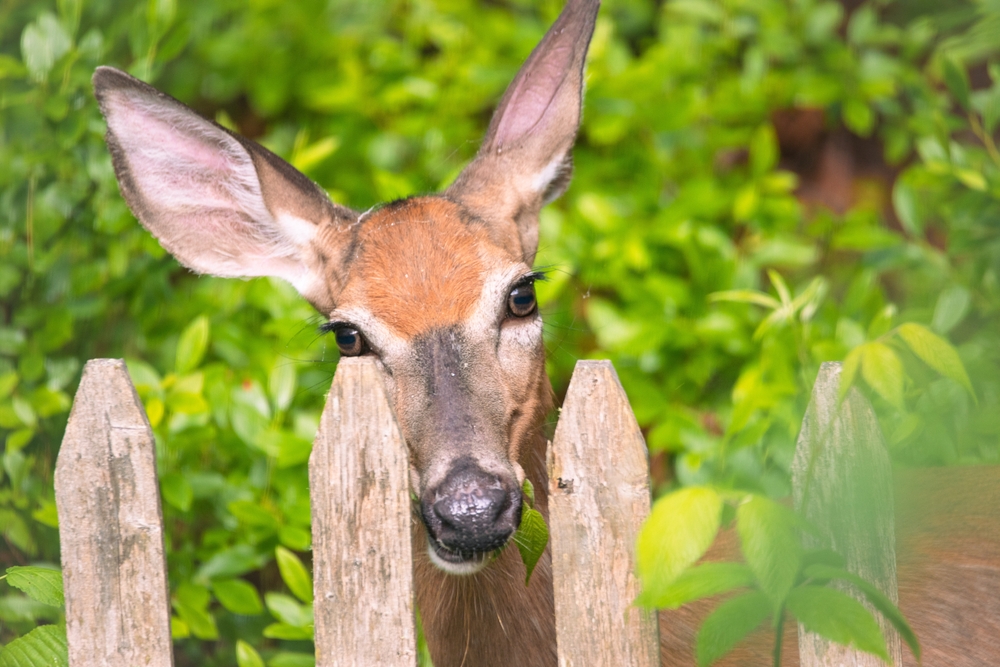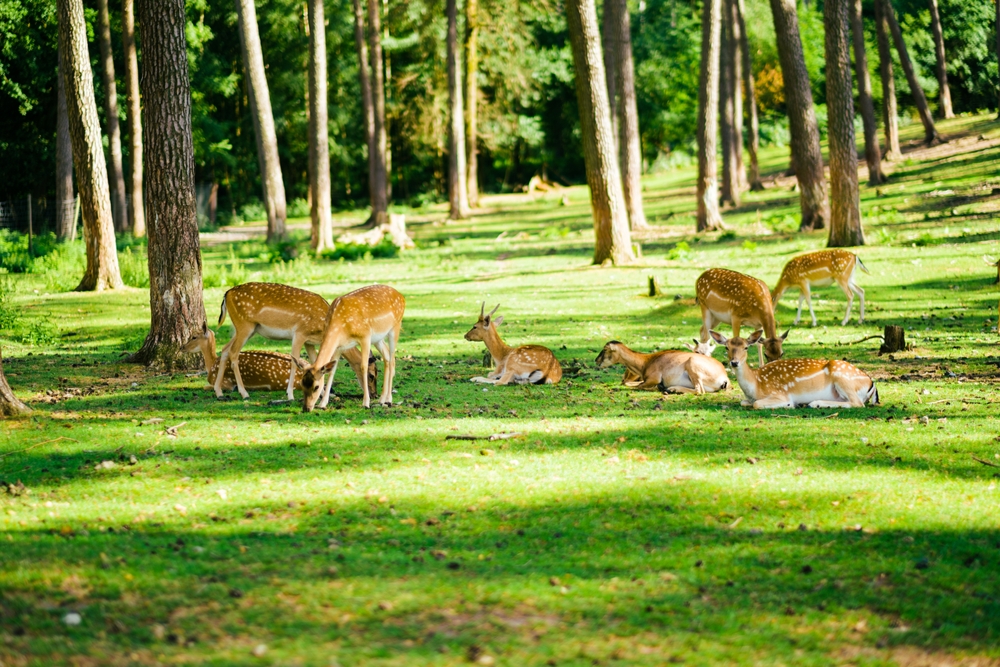
Image Source: Shutterstock.com
If you’ve ever stepped outside on a crisp autumn morning to admire your garden—only to find your prized plants chomped down to sad little stems—you’re not alone. Fall is deer season, and as the temperature drops, their appetites rise. These graceful grazers suddenly become relentless foragers, raiding gardens and landscapes in search of calorie-rich snacks before winter hits.
While you might think your yard is safe, deer are not picky eaters when the cold sets in. And as it turns out, some plants are basically the deer equivalent of a pumpkin spice latte—utterly irresistible this time of year.
1. Hostas: The Salad Bar Favorite
Hostas are like a buffet sign for deer: “All-you-can-eat greenery right here!” Their soft, juicy leaves are easy for deer to chew and digest, making them an instant target once other vegetation starts to fade. In the fall, when the leaves stay tender longer than most perennials, deer see them as one last leafy feast. Even the waxier varieties don’t stand a chance once deer are hungry enough. If you’ve got hostas near the edge of your yard, you might as well put up a “Deer Diner Open” sign.
2. Roses: Thorns Don’t Scare Them
You’d think thorns would stop them—but no, deer are surprisingly unbothered by a little prickly resistance. Come fall, they’re drawn to the soft new growth and the petals that still linger in late-blooming rose bushes. Those fragrant blooms are like dessert after a long day of grazing. They’ll strip the flowers and even nibble on stems if the pickings are slim. If you find your roses mysteriously deflowered overnight, you can bet a deer had a candlelight dinner in your yard.
3. Tulips: A Sweet Fall Snack Before the Frost
Even though tulips won’t bloom until spring, deer love to dig up their bulbs in fall when gardeners start planting them. The bulbs are nutrient-dense and packed with energy, exactly what deer crave before winter hits. They’ll sniff them out like truffle pigs, digging holes that leave your future flowerbeds in shambles. Once they know where to find them, they’ll return night after night like repeat customers. So, if you’ve been wondering who’s raiding your tulip beds—look for hoofprints, not rabbits.
4. Arborvitae: The Green Buffet That Keeps on Giving
Arborvitae are the perfect winter greenery for landscapes—and unfortunately, for deer, too. Their evergreen foliage stays lush even when everything else goes brown, making them a reliable food source. In the fall, deer begin stripping the lower branches, often leaving behind a distinct “browse line” that makes the tree look awkwardly trimmed from the bottom up. Once they start, they can turn a dense hedge into a patchy mess within weeks. If you live in deer country, arborvitae can feel like a lost cause without some protection.
5. Apples: The Deer’s Dessert Orchard
When apples start falling, deer come running—literally. The combination of sweetness and scent draws them in from great distances, and they’ll feast on every piece they can find, from fresh fruit to half-rotten windfalls. As the season cools, the sugar content increases, making apples even more appealing. They’ll strip low branches bare and then comb the ground for leftovers. To deer, an apple tree is basically nature’s candy store.

Image Source: Shutterstock.com
6. Yews: A Forbidden but Favorite Treat
Yews are a dangerous obsession for deer. The evergreen needles are toxic to them in large amounts, but that doesn’t stop them from taking a bite anyway. In the fall, when other greens fade, yews stay vibrant and soft, which makes them a tempting risk. Unfortunately, deer don’t seem to know their limits and will return again and again. Gardeners often wake up to find entire shrubs sheared down to sticks—proof that even poisonous plants aren’t always safe.
7. Hydrangeas: A Fall Feast for Flower Lovers
Hydrangeas might be the pride of your summer garden, but in fall, they’re also a beacon for hungry deer. The tender stems, drying blooms, and lingering leaves offer an easy snack as other plants go dormant. Deer especially love the smoother, softer varieties that stay green late into the season. They’ll chew the buds right off, ruining next year’s blooms before you even realize it. The result? A once-glorious bush turned into a skeleton of its former self.
8. Daylilies: Easy, Edible, and Everywhere
Daylilies seem to grow everywhere, and deer treat them like a casual roadside snack stop. In the fall, they’ll munch through whatever foliage is left, especially since the leaves are still pliable and full of moisture. If flower stalks are still standing, they’ll snap those down too, eating the remaining seed pods for good measure. It’s not unusual for a herd to wipe out an entire patch overnight. Gardeners joke that deer don’t just eat daylilies—they inhale them.
9. Maple Saplings: The Tender Tree Tops
As acorns and other woodland food sources dwindle, deer start targeting young trees, and maple saplings are at the top of the list. The tender bark and new shoots are rich in nutrients and easy to chew. In fall, deer often strip the bark off these trees, which can cause long-term damage or even kill them. If you’ve planted young maples recently, you’ll want to guard them before deer turn them into mulch. Think of saplings as the deer version of a pre-winter protein bar—they can’t resist.
10. Strawberries: The Late-Season Surprise
While strawberries peak in summer, any lingering foliage or second harvests become irresistible to deer once fall arrives. They’ll nose through the plants looking for leftover fruit, and when they don’t find any, they’ll settle for the leaves. Their delicate texture and lingering sweetness make them an easy target. Even if you cover them, deer are notorious for nosing under nets or tearing through barriers if they smell something good. For deer, strawberries are the final sweet treat before the long, lean winter.
Fall Is Feeding Season—Guard Your Garden
By the time the leaves start to turn, deer are in full-on feeding frenzy mode. The plants that seem safe in spring and summer suddenly become irresistible targets as the forest thins and food options shrink. Knowing which plants they crave can help you protect your garden before the damage begins. Whether you choose repellents, fencing, or strategic planting, a little preparation can go a long way toward saving your landscape.
Have you spotted deer nibbling in your yard this fall? Share your stories, tips, or even photos in the comments below.
You May Also Like…
How to Build a Garden That Keeps Deer Out—Without Fencing
Why Morning Dew Affects Disease Rates in Fall
7 Evergreens That Add Color All Winter Long
10 Ornamental Plants That Glow in Fall Sunlight
Why Certain Shrubs Should Never Be Fertilized in Fall
Leave a Reply